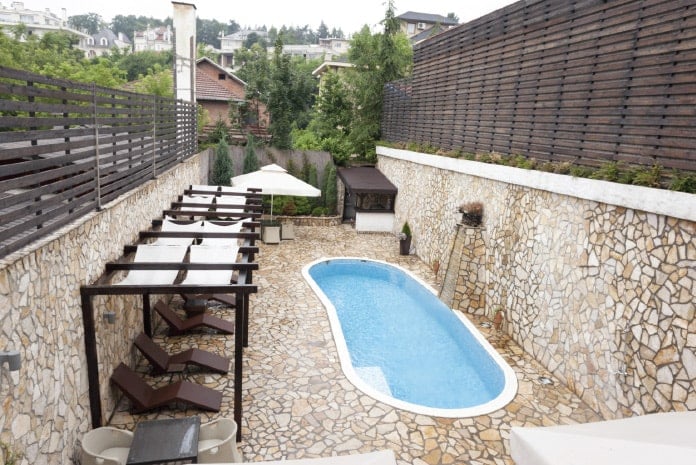One of the greater luxuries of life is to be able to relax and enjoy the sanctity of one’s own personal swimming pool. To know that there is one place in the home you are able to unwind and be in touch with nature. So how do we go about designing our pool? There are a few things to think about when it comes to pool designs and these comprise the following factors: Size, Materials and Shape (SMS). Let us discuss the importance of size. There are many ways to design a pool, but there is a limit to how big or small a pool should be before it stops becoming a pool and ends up either as a water feature or lake.
WHAT IS BIG AND WHAT IS SMALL?
Always avoid an oversized pool. No matter how impressive it may be or how much real estate you may own. The reason being, there comes a limit where the pool loses its intimate qualities and starts to imitate a public pool. So how do we begin?
Start by thinking of the number of lanes a person is able to swim laterally through the pool. Always stick to 4-5 lanes but never more, as any excess would end up being a swim meet. In addition, always avoid incorporating swimming race lines as part of the design, as this would instantly cheapen the aesthetic quality of the pool.
On the other spectrum, you shouldn’t have the pool smaller than two swimming lanes, as this would create a long narrow feature, which would emulate a landscape or lap pool design. The next element to consider is the surrounding areas adjacent to the pool. If we can only afford to set aside a small section of the house to build a pool, make sure that the pool is built in proportion to the surroundings. Avoid placing a small pool where the walls dominate the entire space. Doing so creates a claustrophobic, suffocating experience.


Similarly, avoid building a pool that is too large for the space, as this causes the intimate relationship with the water to be lost and you will then start to feel as if you were cast away in an ocean.
DESIGNS AND MATERIALS
Now that we have established the parameters on the size of the pool, we will need to start looking at materials. First off, we need to ensure that the pool materials we select do not match up with any tiles you have selected in any of the bathrooms.

The second thing to look at are materials as a means to create features. Consider the use of motifs to create a central feature within the pool rather than the monotonous tile effect. By introducing a logo effect on the pool floor, you are able to pull the attention of the user to indicate a section of the pool is somewhat different, and special. This is a great technique to use to indicate steps for entry into the pool, or to indicate a feature such as a hot / cold tub or jacuzzi.

The merging of elements can be done through the use of integrating the beauty of stone or timber as a mirror element to the pool. In this example, there is a symbiosis of form and materials between pool and wall. By introducing a wall that is similar in height as to the width of the pool creates a vertical element to balance out the longitudinal element of the pool. But the play of yin and yang, or opposites, allows the vertical dominating form of the wall to succumb to the feminine peanut form of the pool, creating an interesting, visual relationship.
CREATING INTIMACY

Now that we have understood how size and materials can affect our perception in appreciating a pool, how do we design it such that we are able to create a sense of intimacy? This comes down to how adventurous you are in designing the shape of the pool. The easiest shape is the rectilinear form, which is perfect for laps and general pool usage. But to introduce a special element into the pool feature, all we need to do is add a small element. In this scenario, the semi-circular form anchors a central viewing platform where the pool and deck intersects, creating a single prominent vantage from which to soak in the element of water and view.

In this example, the use of LED ceiling lights creates an artificial moonlit sky effect offering the experience of swimming under the stars (indoor). While the shape of the pool may seem to be regular, the use of an irregular wall pattern helps offset any monotony effect the room may have.

In this example, even though it is a public pool, the T-shaped form serves a dual purpose. First it indicates an entry / exit point into the pool, and secondly, it allows the pool to be visually split into two parts, whereby the square element indicates a shallower play area, while the rectilinear element indicates a lap pool.
So when you consider incorporating a swimming pool into the home, always think of the following SMS elements. Make sure the size balances out with the surroundings, and is in itself a suitable size for swimming / playing in. And once you have determined the size, think of ways of how to play around with materials either through pattern or form. Finally, look at the shape and see how you can start with a rectilinear form and introduce another shape to create a node to serve as a highlight to the pool.
























